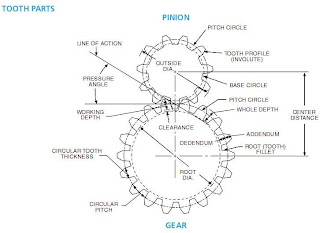NORMAL PLANE is the plane normal to the tooth surface at a pitch point and perpendicular to the pitch plane. For a helical gear this plane can be normal to one tooth at a point laying in the plane surface. At such point, the normal plane contains the line normal to the tooth surface and this is normal to the pitch circle.
NORMAL PRESSURE ANGLE (øn) in a normal plane of helical tooth
.
OUTSIDE DIAMETER (Do) is the diameter of the addendum (outside) circle.
PITCH CIRCLE is the circle derived from a number of teeth and a specified diametral or circular pitch. Circle on which spacing or tooth profiles is established and from which the tooth proportions are constructed.
PITCH CYLINDER is the cylinder of diameter equal to the pitch circle.
PINION is a machine part with gear teeth. When two gears run together, the one with the smaller number of teeth is called the pinion.
PITCH DIAMETER (D) is the diameter of the pitch circle. In parallel shaft gears, the pitch diameters can be determined directly from the center distance and the number of teeth.
PRESSURE ANGLE (ø) is the angle at a pitch point between the line of pressure which is normal to the tooth surface, and the plane tangent to the pitch surface. In involute teeth, pressure angle is often described also as the angle between the line of action and the line tangent to the pitch circle. Standard pressure angles are established in connection with standard gear-tooth proportions.
ROOT DIAMETER (Dr) is the diameter at the base of the tooth space.
PRESSURE ANGLE—OPERATING (ør) is determined by the center distance at which the gears operate. It is the pressure angle at the operating pitch diameter.
TIP RELIEF is an arbitrary modification of a tooth profile whereby a small amount of material is removed near the tip of the gear tooth.
UNDERCUT is a condition in generated gear teeth when any part of the fillet curve lies inside a line drawn tangent to the working profile at its point of juncture with the fillet.
WHOLE DEPTH (ht) is the total depth of a tooth space, equal to addendum plus dedendum, equal to the working depth plus variance.
WORKING DEPTH (hk) is the depth of engagement of two gears; that is, the sum of their addendums.

